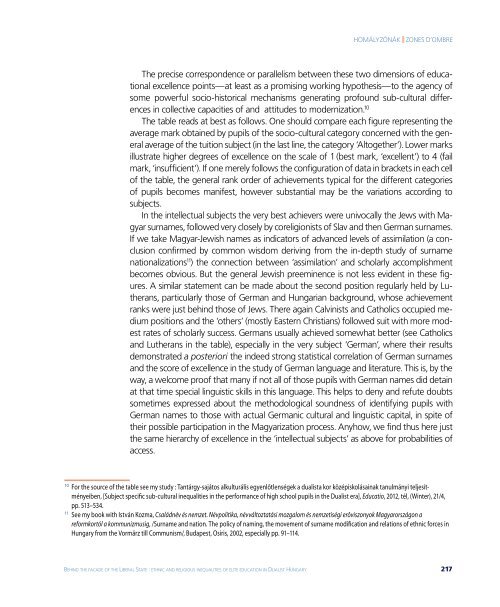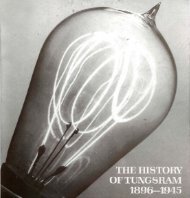Homályzónák Zones d' Ombre - MEK - Országos Széchényi Könyvtár
Homályzónák Zones d' Ombre - MEK - Országos Széchényi Könyvtár
Homályzónák Zones d' Ombre - MEK - Országos Széchényi Könyvtár
Create successful ePaper yourself
Turn your PDF publications into a flip-book with our unique Google optimized e-Paper software.
The precise correspondence or parallelism between these two dimensions of educationalexcellence points—at least as a promising working hypothesis—to the agency ofsome powerful socio-historical mechanisms generating profound sub-cultural differencesin collective capacities of and attitudes to modernization. 10The table reads at best as follows. One should compare each figure representing theaverage mark obtained by pupils of the socio-cultural category concerned with the generalaverage of the tuition subject (in the last line, the category ‘Altogether’). Lower marksillustrate higher degrees of excellence on the scale of 1 (best mark, ‘excellent’) to 4 (failmark, ‘insufficient’). If one merely follows the configuration of data in brackets in each cellof the table, the general rank order of achievements typical for the different categoriesof pupils becomes manifest, however substantial may be the variations according tosubjects.In the intellectual subjects the very best achievers were univocally the Jews with Magyarsurnames, followed very closely by coreligionists of Slav and then German surnames.If we take Magyar-Jewish names as indicators of advanced levels of assimilation (a conclusionconfirmed by common wisdom deriving from the in-depth study of surnamenationalizations 11 ) the connection between ‘assimilation’ and scholarly accomplishmentbecomes obvious. But the general Jewish preeminence is not less evident in these figures.A similar statement can be made about the second position regularly held by Lutherans,particularly those of German and Hungarian background, whose achievementranks were just behind those of Jews. There again Calvinists and Catholics occupied mediumpositions and the ‘others’ (mostly Eastern Christians) followed suit with more modestrates of scholarly success. Germans usually achieved somewhat better (see Catholicsand Lutherans in the table), especially in the very subject ‘German’, where their resultsdemonstrated a posteriori the indeed strong statistical correlation of German surnamesand the score of excellence in the study of German language and literature. This is, by theway, a welcome proof that many if not all of those pupils with German names did detainat that time special linguistic skills in this language. This helps to deny and refute doubtssometimes expressed about the methodological soundness of identifying pupils withGerman names to those with actual Germanic cultural and linguistic capital, in spite oftheir possible participation in the Magyarization process. Anyhow, we find thus here justthe same hierarchy of excellence in the ‘intellectual subjects’ as above for probabilities ofaccess.10For the source of the table see my study : Tantárgy-sajátos alkulturális egyenlőtlenségek a dualista kor középiskolásainak tanulmányi teljesítményeiben,[Subject specific sub-cultural inequalities in the performance of high school pupils in the Dualist era], Educatio, 2012, tél, (Winter), 21/4,pp. 513–534.11See my book with István Kozma, Családnév és nemzet. Névpolitika, névváltoztatási mozgalom és nemzetiségi erôviszonyok Magyarországon areformkortól a kommunizmusig, /Surname and nation. The policy of naming, the movement of surname modification and relations of ethnic forces inHungary from the Vormärz till Communism/, Budapest, Osiris, 2002, especially pp. 91–114.Behind the fac a d e o f the Liber al Stat e : e thnic an d r e l i g i o us i n e q ua l i t i e s o f elite e d u c at i o n in Dua l is t Hung ary217








![Letöltés egy fájlban [4.3 MB - PDF]](https://img.yumpu.com/50159926/1/180x260/letaltacs-egy-fajlban-43-mb-pdf.jpg?quality=85)








